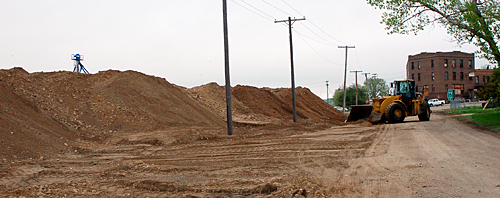Kenmare ND - Features
Real People. Real Jobs. Real Adventures.
Thanks for reading some of the latest features about area people and events.
To view every page and read every word of The Kenmare News each week,
subscribe to our ONLINE EDITION!
Battalion of heavy equipment rolls in to fix railroad line
The Canadian Pacific Railway tracks northwest of Kenmare were left hanging recently when the hills on the west side of the Upper Des Lacs Lake started falling down. Literally.
5/25/11 (Wed)
The Canadian Pacific Railway tracks northwest of Kenmare were left hanging recently when the hills on the west side of the
Literally.
According to Kelly Hogan, project leader for the Souris River Basin National Wildlife Refuge Complex, the hills directly above the
In some cases, the rails were left suspended in the air.
The most serious incident occurred May 14th, and CP Railway officials made the decision to start repairs immediately.
“We suspended operations on the track for the past week to shore up the sub-strata of the track,” said Mike LoVecchio, CP Railway spokesperson, “and we started running trains again Saturday morning. As the slope itself was shifting, it actually shifted the tracks. We’ve had to realign the tracks and underpin them.”
Hogan said the railroad moved the lines five feet to the west of the current route through the affected region. “Now, they’re trying to stabilize that ground,” he added.
Tim Harris of Harris Construction in Kenmare knows all about the challenges of that process, with 10 to 12 of the company’s trucks hauling dirt to the site.
Strata Corporation of Minot and Ames Construction, Inc., also have equipment working on the project. “Some days, we have up 30 trucks out there,” Harris said. The drivers have been hauling dirt every day for the past two weeks, as allowed by the rainy weather.
The contractors are rebuilding the hills, with four excavators from Harris and two apiece from
However, six additional slide areas still need stabilizing this spring, and Harris believes more slumping could occur. “The old coal veins are there, and there’s so much water,” he said.
LoVecchio said CP Railway engineers based in
Slumping is no surprise
Neither Hogan nor Harris was surprised at the situation. The year 2010 ended with a moisture total of 25.13 inches at the Des Lacs NWR, with 6.98 of that coming since September. By the time the hillsides started their descent toward the valley floor in the middle of May, another 6.87 inches of precipitation were measured for the area.
“Everything is just so saturated,” said Hogan, adding that drivers on U.S. Highway 52 heading southeast of Carpio will see several slumped hillsides as they travel.
Hillsides west of Donnybrook along the highway also show many instances of sliding terrain.
The
“I don’t think they’d want to be on it anyway,” he said. “There’s water covering the road in one spot and the rest is wet and muddy, and there are trucks going in and out, with railroad employees and contractors.”
Hogan did not predict when the
Harris expected the stabilizing work to continue for another two to four weeks, depending on the weather and other potential slides. Clean-up operations at the site will take place through the summer, with clay, mud and debris from trees and other vegetation to be hauled away.
With so many semi-trucks driving back and forth to the refuge, Harris asked Kenmare residents to be cautious, especially when approaching Ward County Road 1 (
Rail line through refuge is key piece of infrastructure
Hogan said the U.S. Fish & Wildlife Service and CP Railway have been cooperating to fix the immediate slumping problems and come to a long-term solution.
Although the rail lines are within the refuge boundaries, CP Railway owns a few segments of property and has federally-granted rights-of-way for the rest. “One of the things we’re trying to do is find out just what is owned by the railroad and what is right-of-way,” Hogan said. “This may involve some sort of land exchange.”
He noted the refuge’s
Hogan was pleased at the level of cooperation evident in the situation. The repair work is taking place under special use permits granted by the USFWS, and CP Railway executives and engineers are assessing and monitoring the site. “CP Rail is watching this pretty closely,” said Hogan.
“We expect to have a near round-the-clock presence on the site for the next couple of weeks,” said LoVecchio.
He agreed with Hogan that the two entities were coordinating the repair work successfully. “We have a long-standing relationship with the refuge, and it’s always been a positive one,” he said. “The key is communication, and it’s always been there. We appreciate that.”
LoVecchio listed the safety of CP Railway employees and of the community as two significant considerations in the project, as well as the proximity of the rail line to the refuge. “We’re going to work to ensure continued safe operations,” he said, “as well as minimize impact to the environment. Any disturbance created will be mitigated and managed on an on-going basis.”
He described the affected section as the mainline track from


